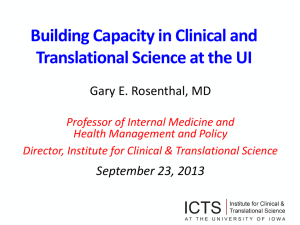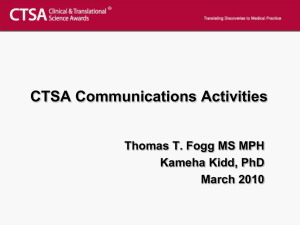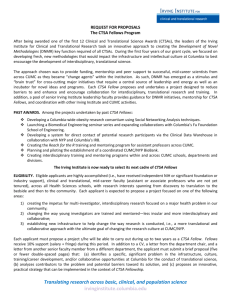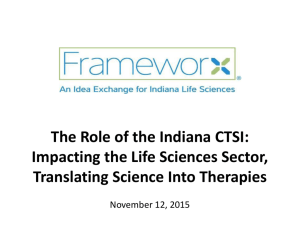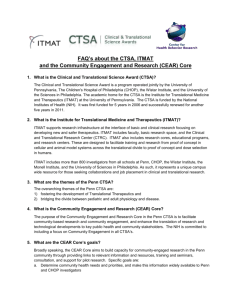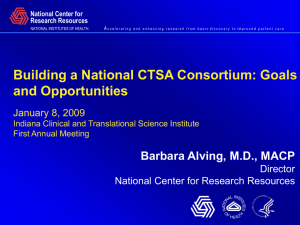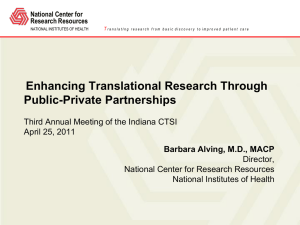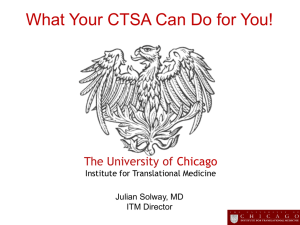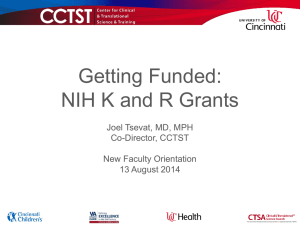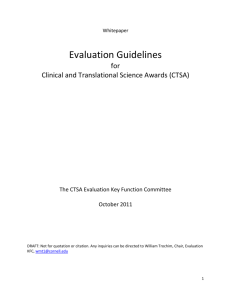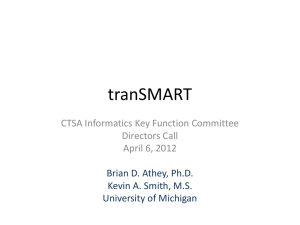Overview - Institute for Clinical and Translational Science
advertisement
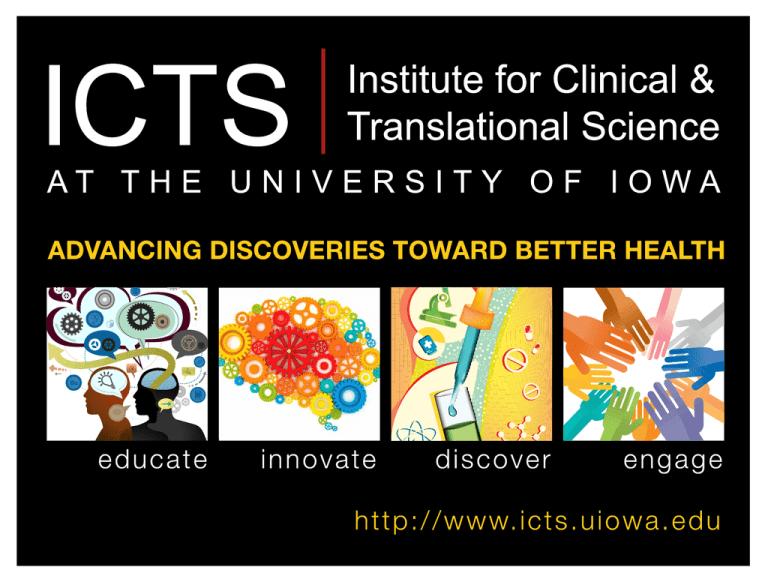
ICTS: Strategic Directions for a Winning CTSA Application Gary E. Rosenthal, MD Professor of Internal Medicine and Health Management and Policy Director, Institute for Clinical & Translational Science February 7, 2014 Goals of Presentation 1. Provide update on the CTSA reapplication 2. Obtain feedback on strategic directions 3. Identify areas of campus need with regard to clinical and translational research (CTR) 4. Garner thoughts on identifying strategies for engaging UI colleges and faculty and trainees Presentation Overview 50,000 Foot Overview Rosenthal Historical perspective of CTSA program National factors shaping the CTSA program Changes in funding model and implications for ICTS Future directions & key areas of program emphasis Review of Key Areas Community Engagement Parker Child Health Widness Clinical Research Support Kline Biomedical Informatics Knosp Education & Training Nopoulos Core Goals of ICTS Provide unique resources & services that enable innovative research to improve human health Education, training, & career development Clinical and translational research (CTR) infrastructures Methodological consultation and support Pilot grants Support entire T1 – T4 spectrum of CTR T1 Lab discoveries to first in human studies T2 Efficacy of new interventions in controlled trials T3 Effectiveness of interventions in routine practice T4 Impact of interventions on populations & policy Promote policies to improve CTR efficiency Historical Perspective of CTSA Program 2006 CTSA initiative launched by NCATS 2007 UI funded in 2nd cohort of grantees 2011 NCRR disbanded & NCATS created as a home for translational research in NIH & the CTSA program 2012 CTSA RFA significantly revised and IOM Committee on the Future of CTSA Program convened 2013 Recommendations of IOM Committee released Major Recommendations of IOM Report: Future of CTSA Program 1. Build on strengths of individual institutions 2. Emphasize innovative education and training programs that are personalized to unique needs of trainees and that promote team science 3. Build engagement of community members and other key stakeholders in all phases of CTR 4. Strengthen CTR relevant to child health 5. Standardize evaluation processes that are built around clear, consistent, and innovative metrics Next Steps by NCATS for CTSA Program 2013 NCATS Advisory Committee established to provide recommendations for responding to IOM Committee / report anticipated in Spring 2014 2013 CTSA Program governance revised Creation of new Steering Committee Streamlining of CTSA Consortium committee Decision to not release RFA & provide additional year of funding to CTSAs with grants ending 4/14 2014 New RFA anticipated by Summer with application due 6 months later (? Jan 2015) Changes in CTSA Funding Model and Financial Implications for UI Initial funding formula based on funding levels of legacy clinical research programs (GCRC, K30, & K12) $6.9 million / year (total costs) New funding model introduced for January 2013 application 3% of total NIH funding of the partnering institutions FY 2011 ($175 M) $ 5.3 M / year (total costs) FY 2013 ($145M) $ 4.4 M / year (total costs) Key Strategic Directions 1. Focus resources on core areas that maximize value to UI CTR enterprise Areas of increasing opportunity for external funding Areas in which there are critical masses of investigators who can successfully compete for external funding Areas of need not being addressed by other programs and centers Closely link ICTS resource allocations to program evaluation data to maximize bang for the buck Key Strategic Directions 2. Closer integration of ICTS with other UI centers & offices & major initiatives in translational science Build on current joint initiatives with Holden Cancer Center, CV Center, and CADRE that leverage resources Build synergies with new high-impact programs (e.g., IIHG, Pappajohn Inst, Eagles Center, Wynn Institute) Link efforts with UIRF, Research Park, and Pappajohn Center to more effectively promote entrepreneurship Broad buy-in for a CTSA program that meets NCATS vision of an integrated home for CTR Next application should be story about CTR at UI! Key Strategic Directions 3. Emphasize rural health as a unique strength and nurture broad range of partnerships to enable research to improve health of rural Iowans Healthcare Providers UI Health Alliance, UI child specialty clinics Practice-based networks FQHCs, CAHs, Irene, Iowa School Nurses) Public Sector IDH and DHS Other CTSAs Midwest research network, PCORnet Patient advocacy groups CF Foundation Key Strategic Directions 4. Enhance capacity in medical informatics to: Provide EMR data for CTR and enable investigators to successfully compete for new funding from PCORI and NIH for practice-based pragmatic trials Promote transformation of UIHC to a Learning Health System in which …. “science, informatics, incentives, and culture are aligned for continuous improvement & innovation, with best practices seamlessly embedded in the delivery process & new knowledge captured as an integral product of the delivery experience” (Institute of Medicine, 2006) Key Strategic Directions 5. Build capacity for conducting innovative clinical trials Work with departments and research centers to recruit experienced clinical trials Facilitate UI applications for participation in national clinical trials networks (e.g., NINDS stroke network) Develop regional clinical research partnerships (e.g., MOU with Mercy Des Moines, MARCH network) Work with UIHC to incorporate ‘access to cutting-edge clinical trials’ into hospital marketing strategies Create dedicated unit for conducting Phase 1 and Phase 2 trials of novel therapeutic Key Strategic Directions 6. Position UI with NIH & industry as a preferred site for conducting clinical trials Capitalize on capabilities in Epic EMR to identify eligible and recruit eligible subjects Be a leader nationally in subject recruitment Promote an efficient research environment regulatory culture Be a leader nationally in adopting shared IRB & contract relationships & decreasing regulatory barriers Implement the Iowa Heroes Subject Registry Increase awareness and access of Iowans to clinical trials Key Strategic Directions 7. Support the successful ‘K’ to ‘R’ transition of junior investigators (~50 NIH K, institutional K12, VA, and professional society career development awardees) through K Clubs Professional development seminars Workshops to guide trainees through different components of R01 type grants and to develop competitive first submissions Mock study sections
